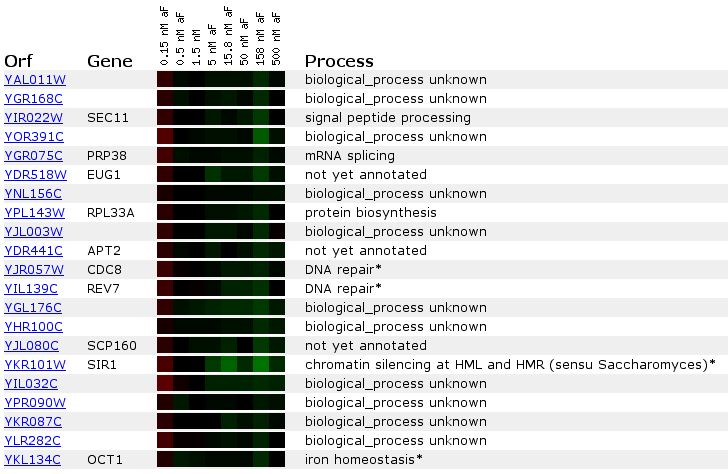This web page was produced as an assignment for an undergraduate
course at Davidson College
YAL011w is an unannotated ORF that could hint at
its own function as more data is collected from microarrays. This
ORF is coordinately expressed with other genes in response to
a changing cellular environment. Here is some information that
reveals clustered expression of YAL011w with other
genes. “Guilt by association” implies that genes showing similar
expression patterns may have similar functions but various patterns
of clustering require a more analysis to elucidate the function of a gene.
The true source of data for clustering of YAL011w in response to changing
cellular and environmental conditions can be found at this website after
running a search with YAL011w: <http://genome-www4.Stanford.EDU/cgi-bin/SGD/expression/expressionConnection.pl>
Please read my other link on
YAL011w if you are
totally unfamiliar with this ORF. The microarray clustering of Yal011w
should appear similar the figure below:

I) Expression of YAL011w in response to different concentrations
of alpha factor
YAL011w clusters very weakly with two annotated
genes SEC11 and PRP38 during exposure to alpha factor. These two
genes are responsible for protein
modification and RNA splicing respectively.
II) Timed expression of YAL011w in response to a constant concentration
of alpha factor
YAL011w clusters with RPS0B and TAF145 after
60 minutes exposure to alpha factor. RPS0B and TAF145 function as
kinases and RNA transcription regulators respectively. Because
YAL01w is a mitochondrial transmembrane protein, it may
modify a cytosolic protein kinase that in turn exerts feedback in transcription.
III) Expression of YAL011w in response to DNA damaging agents
The microarray data for the expresison
of YAL011w for the dun1 mutant tells an interesting story. Genomic
DNA
hybridizes with strong induction of YAL011w when the dun1 gene is deleted.
Thus dun1 mutants may be viable only when
another part of the chromosome containing YAL011w is duplicated.
Dun1 is a protein kinase that is responsible for repairing
damaged DNA <
http://genome-www4.stanford.edu/cgi-bin/SGD/YPD/ypd.pl?sgdid=S0002259>.
YAL011w most likely
does not complement the dun1 mutation beause it is located in the mitochondrial
membrane, not the nucleus. However, it may
be that YAL011w modifies another protein that can complement the dun1
mutation.
IV) Expression of YAL011w during the cell cycle
The microarray data for YAL011w indicate that
it is not involved in the cell cyle. There is onne point where YAL011w
is
slightly inducted but this is most likely the result of mitochondria
dividing so as to equip the new daughter cell with these
organelles. As the mitochondria divide, their integral membrane
proteins must be transcribed again and this transcription most
likely results in the peak for YAL011w.
V) Expression of YAL011w during the diauxic shift
During the diauxic shift, the yeast are transferred
from an anaerobic to an aerobic environment. YAL011w clusters most
closely during this environmental change with two genes of unknown
function. The most similarly clustered annotated gene
(RGR1) is involved in assisting RNA polymerase II. This is the
third time
that YAL011w has clustered with a gene involved in regulating transcription.
The other two transcription regulators were
PRP38 and TAF145.
It may be that the protein modified by YAL011w, if YAL011w does indeed
modify a protein involved in transcription, has a
unique tertiary
structure as a result of the interaction that allows it to enter the
nucleus and work on RNA.
VI) Expression of YAL011w during sporulation
Once again, we have a case here where YAL011w
clusters with a gene known to regulate mRNA splicing (SYF2). SYF2
is also a participant in the cell
cycle < http://genome-www4.stanford.edu/cgi-bin/SGD/locus.pl?locus=SYF2>,
which might lead credence to the notion that
the induction of YAL011w does not
simply correspond with the division of mitochondria during cell division.
VII) Expression of YAL011w during histone depletion
The expression of YAL011w is seriously repressed
in response to histone depletion. This phenomenon leads credence
to
the notion that YAL011w modifies transcription indirectly by regulating
other transcription factors. During histone depletion,
DNA may be damaged since histones regulate the chromatin that maintains
the integrity of DNA structure. Since the cell does
not want to transcribe damaged DNA, it follows that YAL011w would be
repressed during histone depletion if it was
indirectrly involved in RNA transcription.
VIII) Other expression patterns of YAL011w
The expression pattern of YAL011w does not change
significantly in response to the environmental changes induced by the
authors of the microarray data at:<http://genome-www4.Stanford.EDU/cgi-bin/SGD/expression/expressionConnection.pl>.
Tup1 deletions and Yap1 overexpression neither change significantly
the expression patter of YAL011w.
<http://cmgm.stanford.edu/pbrown/explore/tupsearch.html>
References Cited
1) Saccharomyces Genome Database
[online database]. Available from:
http://genome-www4.Stanford.EDU/cgi-bin/SGD/expression/expressionConnection.pl
Accessed 2001 Oct17
2) Saccharomyces Genome Database [online databse]. Available
from: <http://genome-www4.stanford.edu/cgi-bin/SGD/YPD/ypd.pl?sgdid=S0002259>
Accessed 2001 Oct 17
Click here to email me at seburke@davidson.edu
Click here to return to the Davidson College webpage at bio.davidson.edu/genomics/
